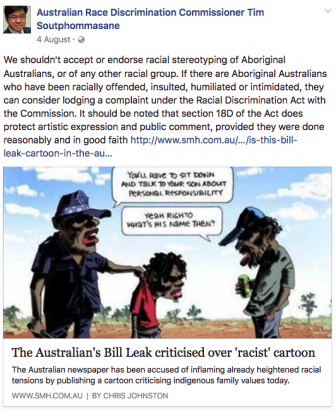 The judicial enforcement of section 18c of the Racial Discrimination Act 1975, Australia’s most notorious “hate speech” censorship law, was boosted in late 2011 when the applicants in Eatock v Bolt succeeded in their claim for declaratory and injunctive relief in the Federal Court of Australia. Even then, however, it was predictable that their success would come to be regarded by some observers as a Pyrrhic victory in the evolving broader controversy about free speech in contemporary Australia. The reality is that the prominent contrarian, Andrew Bolt, has, almost single-handedly, installed the free speech versus “hate speech” censorship controversy – a controversy about the general right to have and express ideas and opinions – at the forefront of public debate.
The judicial enforcement of section 18c of the Racial Discrimination Act 1975, Australia’s most notorious “hate speech” censorship law, was boosted in late 2011 when the applicants in Eatock v Bolt succeeded in their claim for declaratory and injunctive relief in the Federal Court of Australia. Even then, however, it was predictable that their success would come to be regarded by some observers as a Pyrrhic victory in the evolving broader controversy about free speech in contemporary Australia. The reality is that the prominent contrarian, Andrew Bolt, has, almost single-handedly, installed the free speech versus “hate speech” censorship controversy – a controversy about the general right to have and express ideas and opinions – at the forefront of public debate.
The chief vice exemplified by such censorship is that its promoters insist that public debate and disagreement about specific categories of ideas and opinions, in the case of 18c, race, (skin) colour, nationality or ethnic origin, must be burdened by a special restrictive privilege to protect the alleged tender feelings of specific groups of the citizenry. The rationale is a concocted ideology whose adherents patronisingly assert that entire “oppressed/vulnerable minorities” lack the ordinary fortitude, self-respect and dignity of all human beings who live in a free society in which everyone’s cherished ideas and opinions are open to challenge.
There is a King Canute-like determination in the pro-18c camp insistence, embraced by the ALP, that the Abbott government’s 2014 repudiation of its pre-election promise to repeal 18c (also predictable) means that debate on 18c has to stop. That indignation is self-defeating. Even without Senators Leyonhelm, Day, Hinch and Roberts, the 18c controversy would not go away. We are told that the numbers aren’t there to repeal 18c. Amendment, by way of deletion of the words “offend” and “insult” would be mere window-dressing about shades of legislative abstraction and it would leave intact the repressive administrative enforcement role of the Australian Human Rights Commission. Although repeal should be insisted upon, it does not matter greatly if that has to wait. If 18c is here to stay for the medium term, then – as day follows night – so also is the debate about it.
Senator Leyonhelm has lodged his own 18c complaint arising from publication of an article by the Fairfax columnist, Mark Kenny. Kenny expressed himself in terms cynical, derisory and mocking. He called Leyonhelm “a boorish, supercilious know-all with the empathy of a besser block”, and added that he was a “gormless” individual given to making declarations with “angry-white-male certitude”. The Senator is a grown-up. He is not offended by Kenny’s words, but he says he wants to use 18c to demonstrate its absurdity. However, in this fellow fringe-dweller’s view, nothing should be done to encourage the AHRC to exercise its statutory power to compel dissenters to participate in behind-closed-doors conciliation – a kind of re-education in the precepts of “anti-hate speech” groupthink. A far better strategy is to continue heaping good old-fashioned hatred, contempt and ridicule on the menace to Australian democracy inherent in the authoritarian ideology underpinning 18c.
There is postmodern irony galore in the entire pro-18c narrative. First, if the purpose of 18c is to suppress racist hate speech – a meaningless abstraction, but very effective as an emotive propaganda tool – its judicial enforcement is likely to be inherently self-defeating. In 2011, Bolt and his newspaper publisher were permanently restrained by the court’s order from further publishing or republishing the two offending articles, but they were not prevented from continuing to publish them on the newspaper’s website for historical or archival purposes, provided that such publication was accompanied by a court-ordered corrective notice. (Curiously, there was no appeal.) Moreover, both offending articles appear in facsimile form as part of the Federal Court’s judgment on liability, which is easily accessible on the court’s and AUSTLII websites. And a fair/honest report of the court’s decision can reproduce the “offensive” item, albeit with the corrective notice.
Anyone contemplating resort to 18c now needs to consider the prospect that his or her grievance might be dealt with in the court of public opinion and entered on some permanent public record. If the 18c case Prior v Queensland University of Technology pending in the Federal Circuit Court is any guide, the circumstances surrounding the lodging of any 18c complaint with the AHRC are likely to be subjected to scathing public criticism.
Secondly, there is the truly puzzling opportunism of the “hate speech” censors and their supporters who simultaneously condemn and disseminate that which they condemn. This is happening on a daily basis in the controversy arising from Bill Leak’s cartoon published in The Australian on August 4 dealing with the ABC Four Corners programme concerning the treatment of detained indigenous youth offenders in the Northern Territory. Leak entered forbidden territory by linking parental neglect and juvenile delinquency. The AHRC Race Discrimination Commissioner Tim Soutphommasane immediately denounced Leak on his Facebook page and Twitter feed contending that Leak was to be taken as accepting or endorsing racial stereotyping of Aboriginal Australians.
But what in the world possessed the Commissioner to republish the cartoon as part of highlighting its “offensiveness” if it should not have been published in the first place? And is his ongoing republication of the cartoon not “harmful”, not inflammatory? And for what or whose purpose did he make the Delphic observation that section 18d of the RDA “does protect artistic expression and public comment, provided they were done reasonably and in good faith”?
Next, in the realm of 18c, ideology trumps the truth. Bolt had not helped his case in 2011 by getting the facts wrong in some respects. However, as the Court’s judgment on liability makes clear, truth is not necessarily a defence to a 18c claim if, for example, the “tone” of an offending publication is, as the Court characterised Bolt’s language, cynical, derisory or mocking.
In Prior, the court has reserved its decision on the respondents’ application for an order that the complaint be summarily dismissed. If the AHRC prevails on that preliminary issue, the future of the case will depend in part on the outcome of the respondents’ separate statutory complaint that the AHRC’s prolonged investigation of the complaint was fundamentally unfair to them. This is now the subject of an external inquiry which may examine the glaring contradiction between the AHRC’s complaints resolution power and its advocacy functions which it zealously exercises. That contradiction was brought into sharp relief again when, fresh from denigrating and stereotyping the 17.5 million Brits who carried the Brexit vote, the Commissioner (and arguably, therefore the AHRC itself) urged Aboriginal Australians who had been “racially offended, insulted, humiliated or intimidated” (the language of 18c which reflects the obscurantism long favoured by censors) by Leak’s cartoon, to consider lodging an 18c complaint.
On the chances of any such complaint resulting in Leak and The Australian succumbing to some of the aforesaid statutory re-education at the AHRC Camp Groupthink, the bookmakers could be expected to declare with multicultural certitude, “write your own ticket, sport!”
The author is a Melbourne barrister.
Got something to add? Join the discussion and comment below.
Get 10 issues for just $10
Subscribe to The Spectator Australia today for the next 10 magazine issues, plus full online access, for just $10.

























Comments
Don't miss out
Join the conversation with other Spectator Australia readers. Subscribe to leave a comment.
SUBSCRIBEAlready a subscriber? Log in